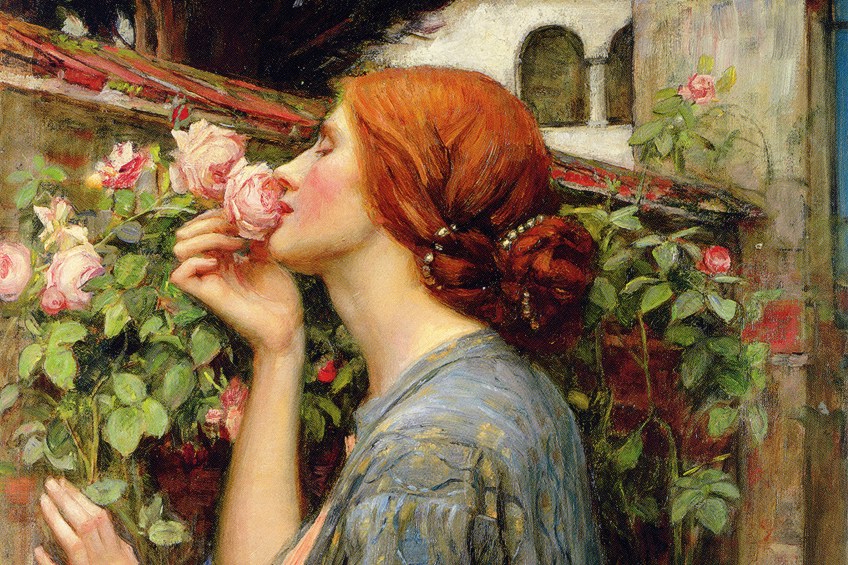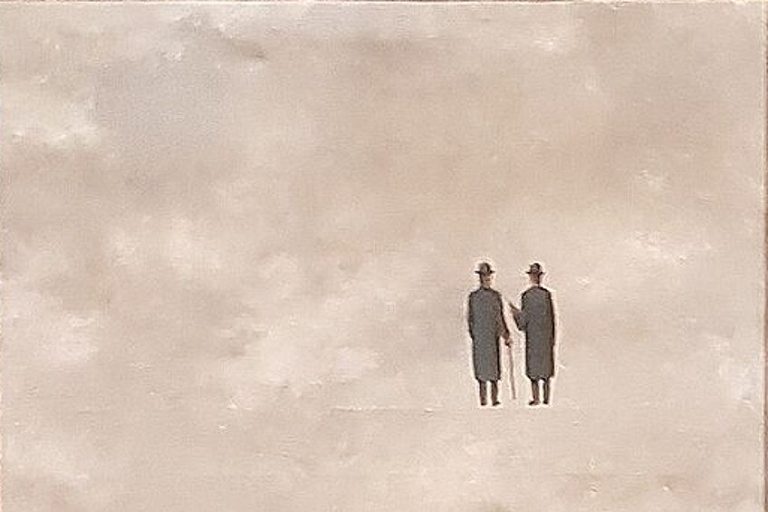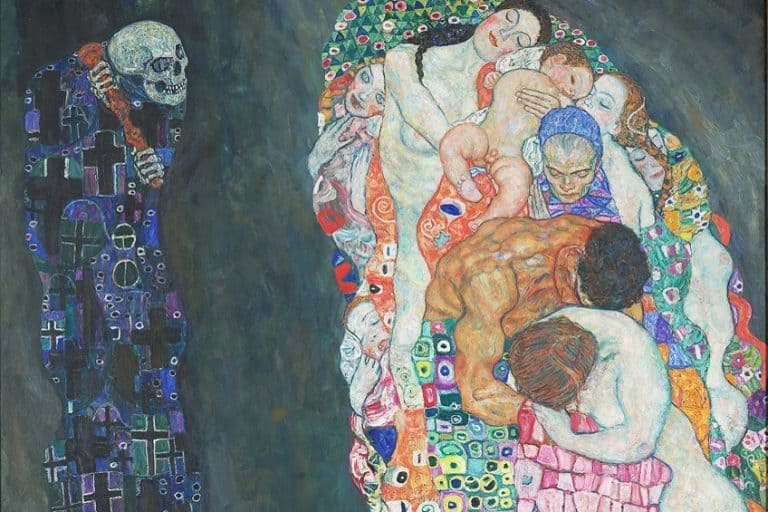“The Soul of the Rose” by John William Waterhouse
The Soul of the Rose (1908) painting by John William Waterhouse is a visual testament to qualities we know and feel so well; love, sensuality, adoration, heartbreak, longing: romance in all its gore and glory. The article below will discuss this artwork, what it symbolizes, and its stylistic qualities.
Table of Contents
Artist Abstract: Who Was John William Waterhouse?
John William Waterhouse was born in Rome in 1849, and died on February 10, 1917, in London. His date of birth has been debated, some scholars say it was in February and others state it was in April, which was reportedly the month of his baptism. He moved to England with his parents when he was young, both of whom were artists. He studied at the Royal Academy of Art in London.
His art styles included Classical and the pre-Raphaelite, he also explored classical art themes like Greek mythological figures, and most notably from the Medieval ages like Arthurian mythology/legend.

His subject matter comprised mostly of women as the central characters, and he was also inspired by literary characters from authors like Alfred Tennyson. Waterhouse was also a teacher at the St John’s Wood Art School in England.
The Soul of the Rose (1908) by John William Waterhouse in Context
The Soul of the Rose by John William Waterhouse, also titled My Sweet Rose, is an early 20th-century oil on canvas. It depicts the alluring sensuality characteristic of the artist’s painting oeuvre and his exploration of the female figure in just one of her many everyday settings surrounded by nature, beauty, and romance.
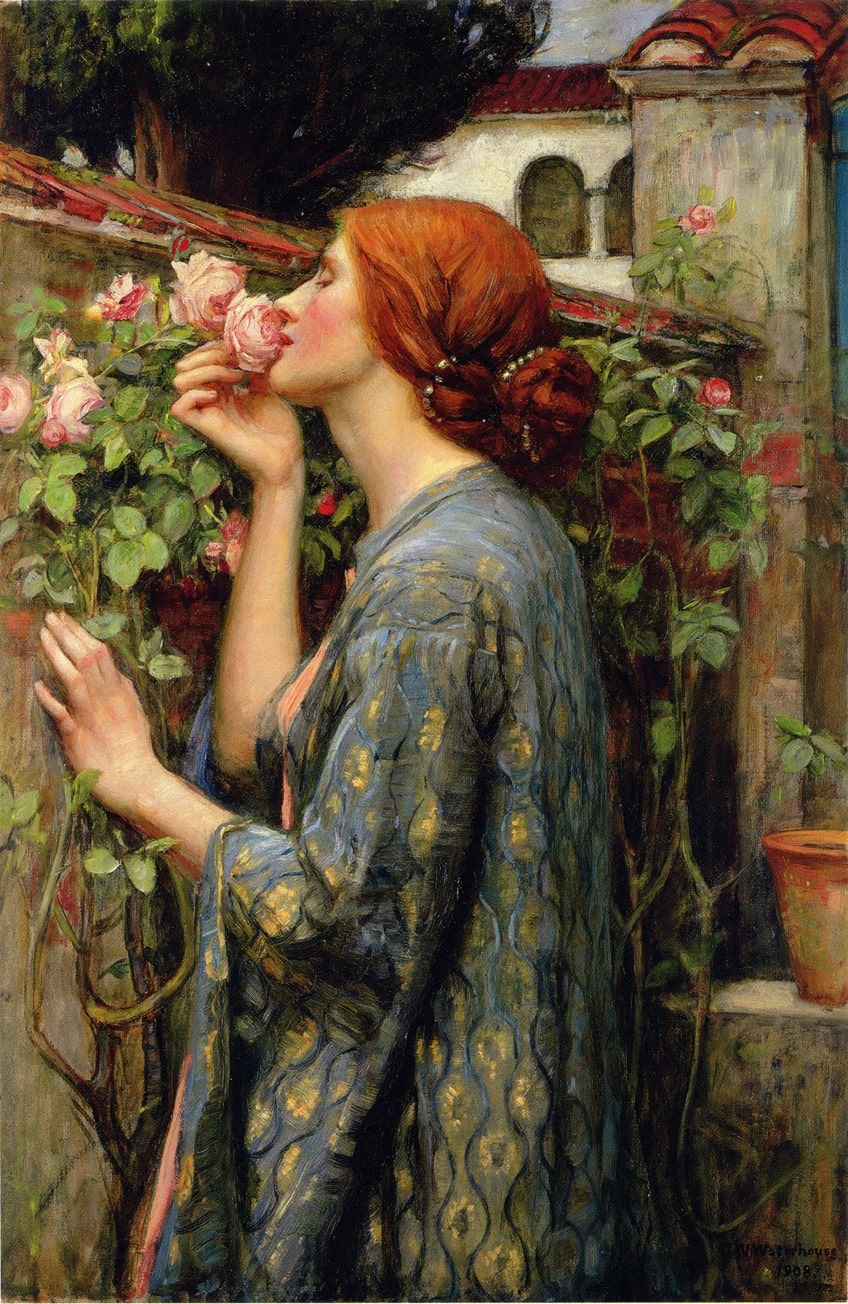
We will discuss The Soul of the Rose painting in more detail, starting with a brief contextual analysis of the related socio-historical factors, followed by a formal analysis of Waterhouse’s stylistic approaches in terms of subject matter, color, and various others.
| Artist | John William Waterhouse |
| Date Painted | 1908 |
| Medium | Oil on canvas |
| Genre | Genre/Literary painting |
| Period / Movement | Pre-Raphaelite/Romanticism |
| Dimensions | 88.3 x 59.1 centimeters |
| Series / Versions | N/A |
| Where Is It Housed? | Private collection |
| What It Is Worth | Estimated worth is over $4 million |
Contextual Analysis: A Brief Socio-Historical Overview
John William Waterhouse’s subject matter comprised mainly of women from mythology like Greek and Arthurian/Medieval tales and legends. These women were often portrayed as heroines or as some art sources say, the “Femme Fatales”, from narratives about tragedy, love, and loss.
Waterhouse painted in a style reminiscent of Classical realism and Romanticism, and he is often attributed to the pre-Raphaelite Brotherhood art movement. His paintings depict naturalistic landscapes, and his figures emanate beauty and softness amidst their seeming turmoil or power.
What Was the Pre-Raphaelite Brotherhood?
The pre-Raphaelite Brotherhood formed in 1848 in London, England, from several artists’ growing reactions against the Royal Academy of Art and its veneration of the High Renaissance, which included the art of artists like Raphael, and the idealistic qualities applied to the representation of nature and the human figure.
The pre-Raphaelites believed in art from the Medieval and early Renaissance, otherwise Quattrocento, time periods when the focus was more on naturalism and realism as opposed to idealism. Their subject matter also related to themes that were more serious in tone with important and earnest messages. This is also how their name, the “pre-Raphaelites”, originated.
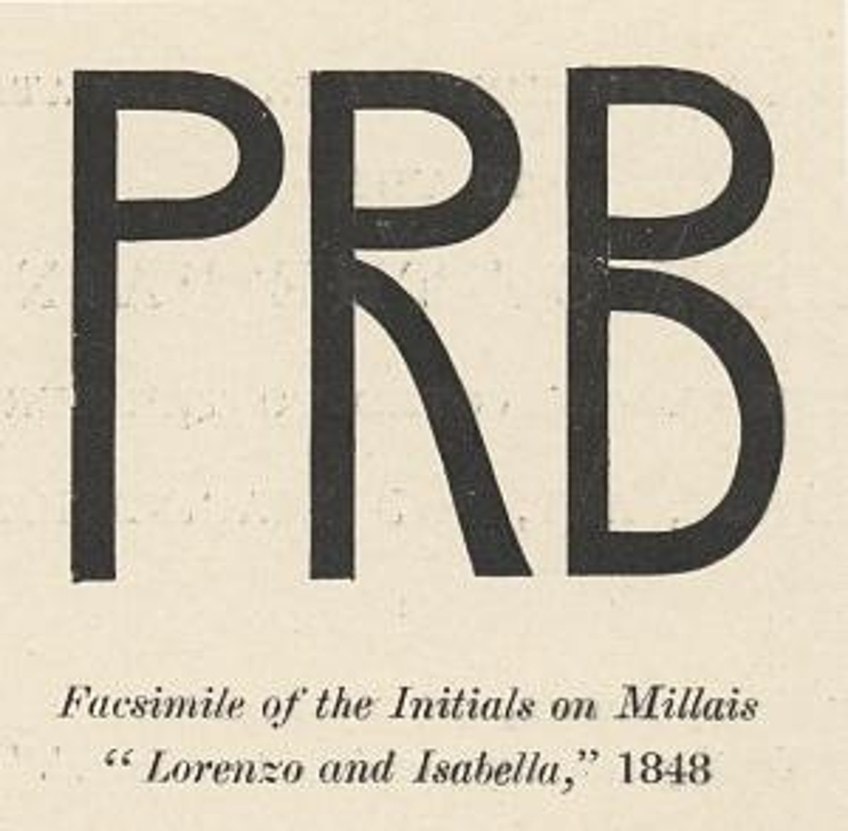
As a secret society, the pre-Raphaelite Brotherhood was started by three artists, namely William Holman Hunt, John Everett Millais, and Dante Gabriel Rossetti, and grew to seven members, all of whom were either painters, poets, sculptors, or scholars.
Some of the main characteristics of the pre-Raphaelite Brotherhood were related to their rejection of the Royal Academy’s ideals, as well as the impacts that Industrialization had on British society. They sought to emulate ideals like morality, truth, expression, and staying true to nature in their art, ideals similarly espoused by Medieval and early Renaissance art.
The pre-Raphaelites influenced many others throughout the years, including the decorative arts and literature. Their ideas were revolutionary and against the systems imposed by Industrialism. It was also a socially tumultuous time in England during the 19th century, and many social classes questioned their place in society. This ultimately contributed to new perspectives and ideas.
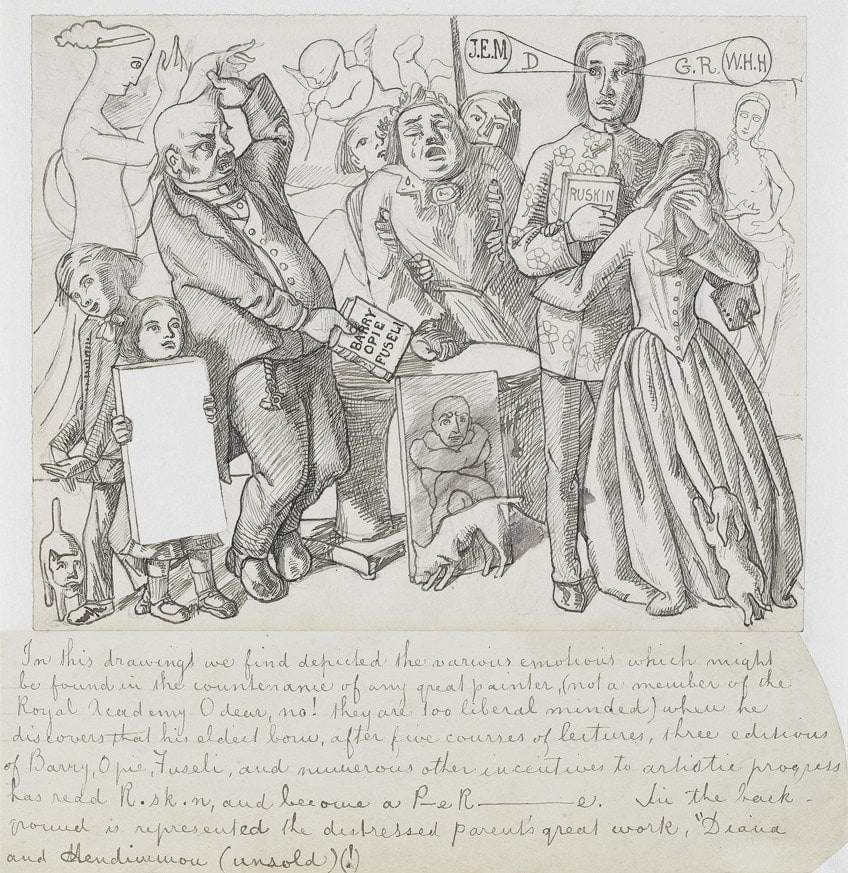
Literary Influences and Symbolisms: Courtship, Enclosed Gardens, and Roses
There are three important ideas and motifs inherent in The Soul of the Rose painting by John William Waterhouse, namely, the significance of the rose, which interconnects with the ideas of courtship and enclosed gardens, which the latter was a large part of the Medieval ages.
It is important to keep these ideas in mind as we explore the subject matter in the formal analysis below.
The rose is an important motif in The Soul of the Rose by John William Waterhouse and there are several literary influences that reportedly inspired the artist, namely, the poem, and what is called a “Monodrama”, Maud (1854) by the English Alfred, Lord Tennyson. The poem was published in the collection titled Maud and Other Poems in 1855.
The poem Maud, sometimes also referred to as Come into the Garden, Maud, is about passion, love, loss, and deep longing. The “narrator” of the poem falls in love with the woman named Maud, but their lives are tumultuous. His father committed suicide, reportedly because of his business partner, who in turn, is Maud’s father. Maud’s brother also posed a threat to the two lovers and the narrator killed him in a duel.
When the narrator invites and waits for Maud to come into the garden, it is here that we learn about the rose and the deep affection held for Maud.
Some scholarly sources also state that the poem’s tone is one of “hope” and that the narrator waits for his love to come to him. The poem starts with “Come into the garden, Maud”, but it is from stanza six, line one, that we are given the vision of the rose, “and the soul of the rose went into my blood”.
Another literary influence mentioned by other art sources includes the poem Le Roman de la Rose or “The Romance of the Rose” (c.1230) by the French poet Guillaume de Lorris. The rose is a symbol of the woman being wooed in what is usually described as a “walled garden”. This also relates to the literary Medieval ideas of “courtly love”, which is about love expressed through chivalry.
Furthermore, the above-mentioned walled garden, otherwise known as an “enclosed garden” or hortus conclusus in Latin, was widely referenced during the Medieval times because it symbolized purity and virginity, and was associated with the Virgin Mary.
It was also, in the more literal sense, an enclosed garden that offered more privacy from the outside world. Often, these gardens would be filled with flowers and foliage to make them beautiful, comfortable, and seemingly paradisaical. Undoubtedly, roses would feature, being common symbols of love.
Formal Analysis: A Brief Compositional Overview
Below, we will take a closer look at The Soul of the Rose by John William Waterhouse, the subject matter as well as the artist’s stylistic approaches to elements like color, and lighting, among others. Let us start with the subject matter.
Subject Matter
The central figure in The Soul of the Rose painting is a woman, she is seen from a side angle, sniffing a pink rose growing against a wall. Her right hand holds the rose to her nose, while her left hand gently rests against the wall.
The woman is elegantly dressed in a bluish and loose robe or dress. The material appears silky and soft with gold patterning on it, and it effortlessly flows down her figure. She has reddish-brown hair fastened in a plaited bun behind the lower part of her head and neck, showing us that she has long hair if it was loose; there are beads or pearls in-between her plaited bun.
Her skin is a soft, pale tone with rouged cheeks.

She is an embodiment of femininity, beauty, and sensuality, completely immersed in her experience of sniffing the rose, seemingly oblivious of the world around her. Her eyes appear closed and her head is slightly tilted upwards as he holds the rose to her nose. If we look closely, her red lips almost blend in with the rose held against them. We wonder, is the woman just an extension of the rose itself?
An interesting fact about the woman is that she could have been either the model Miss Muriel Foster or Beatrice Ethel Hackman, who was younger. Both women were models for Waterhouse for several of his paintings.
If we look at the surroundings, it is evident the woman stands in a courtyard of sorts. Behind her, in the lower right part of the composition, is a plant pot and what appears to be a sliver of a window just above it, the rest of the building is out of our view. She is possibly in an enclosed garden.

The wall she leans on is closer to the foreground, and it seems to be containing her, separating her from the other side. Against this wall, we also see the rose bush with several pink rosebuds scattered around it. In the background, there is an Italian-styled building or villa, its upper section and the red-tiled roof is visible beyond the high wall.
A portion of a large tree is also visible beyond the wall, its large tree trunks and branches reaching taller than the building next to it.
Color and Light
The color scheme in The Soul of the Rose by John William Waterhouse painting comprises soft and neutral tones. There are cool and warm colors creating a harmonious combination. For example, the neutral earthy tones of the surrounding buildings and walls complement the softer, cooler tones from the woman’s dress/robe and pale skin tone.
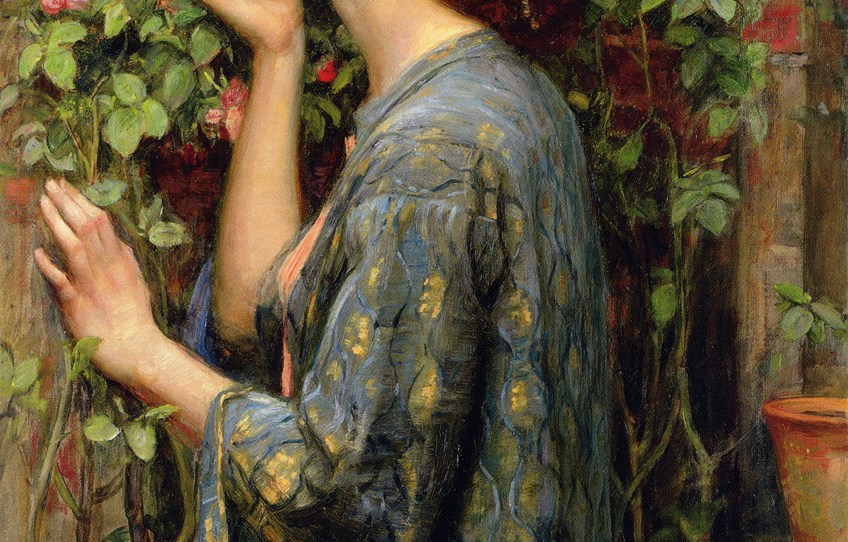
This is also coupled with the warmer colors from the gold patterns and pink roses. There are also hints of pink on her robe or dress, blending delicately with her skin tone. A deep red is echoed in the rooftop tiles as well as the woman’s red hair. There is a natural light source in the composition, illuminating the figure and her surroundings in a softened manner. This emphasizes realism.
An example includes the figure’s clothing, which appears lighter in color on her upper back and as it moves down, the color becomes darker, denoting shadow and light.
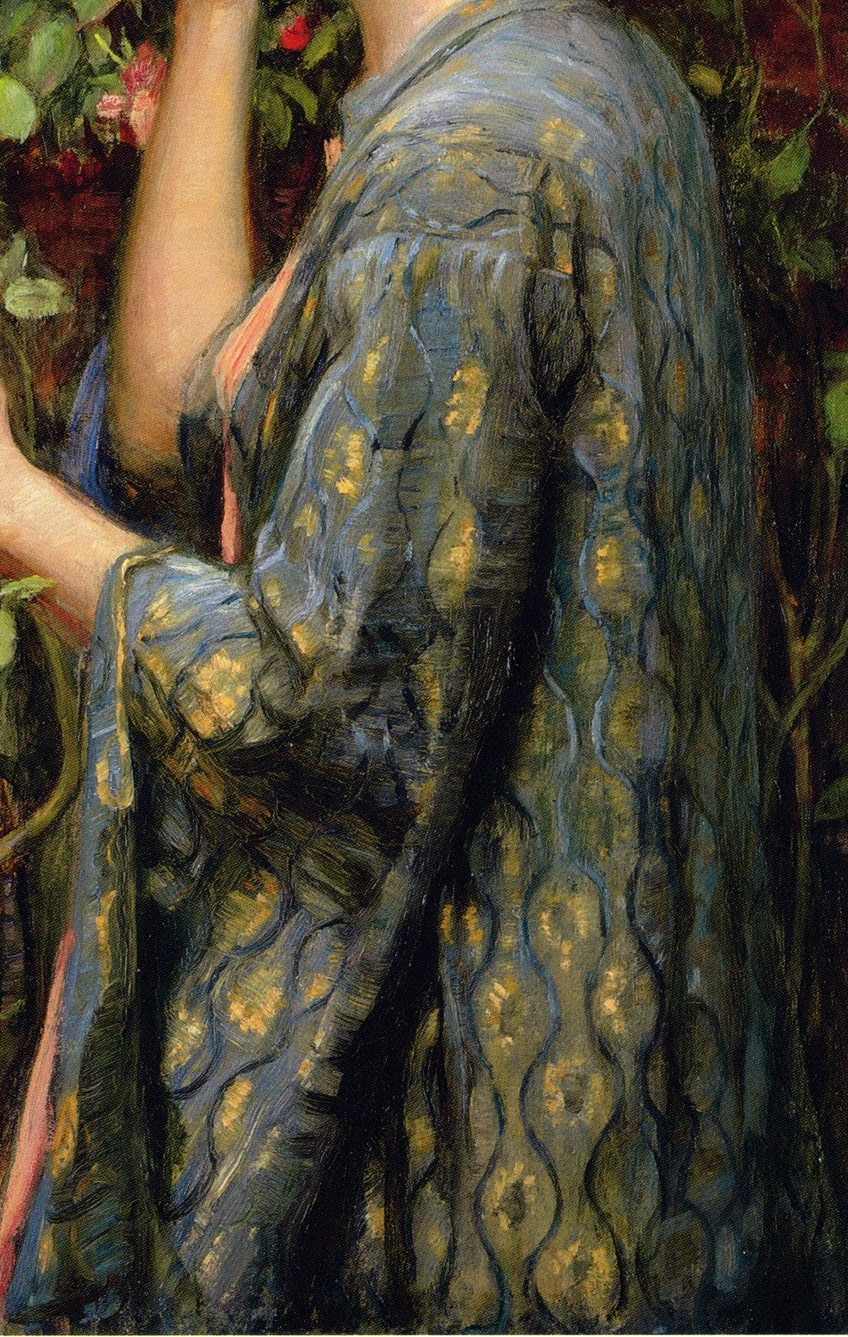
Texture
Waterhouse utilized thicker brushstrokes with a freedom of expression, we can see the visible brushstrokes in the background building and tree. Furthermore, there are more detailed areas, which are applied with finer brushstrokes. These are notable in the woman’s facial features, her hands, the roses, and the detailing on her clothing.
A distinction between the background and foreground has also been made, and the finer details in the foreground emphasize the central figure and narrative.
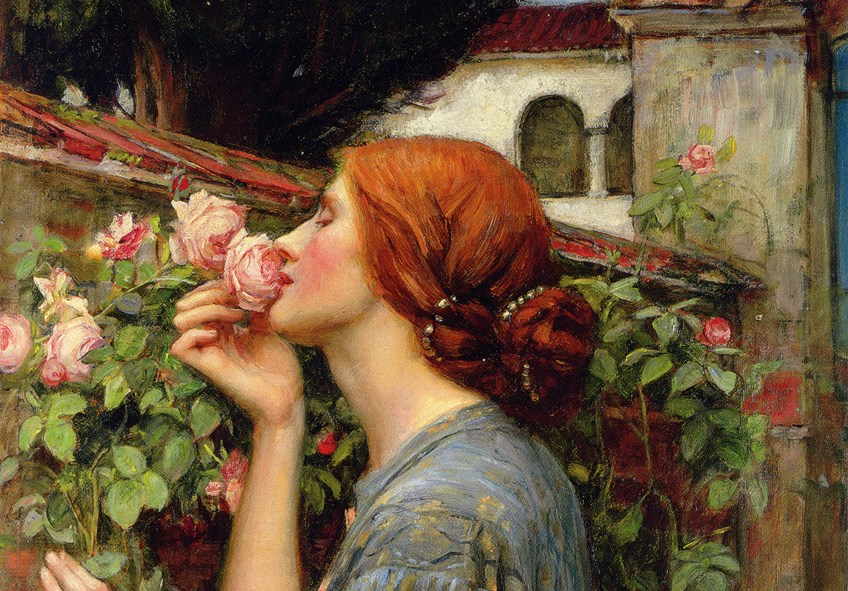
Perspective
This leads us to the perspective of the painting; the background has been given “secondary” importance and the foreground is where our attention is drawn to. We are facing the central figure almost at eye level, as if we can step into the composition at any moment.
She further fills up the foreground, giving us no choice but to engage with her experience and her feelings.
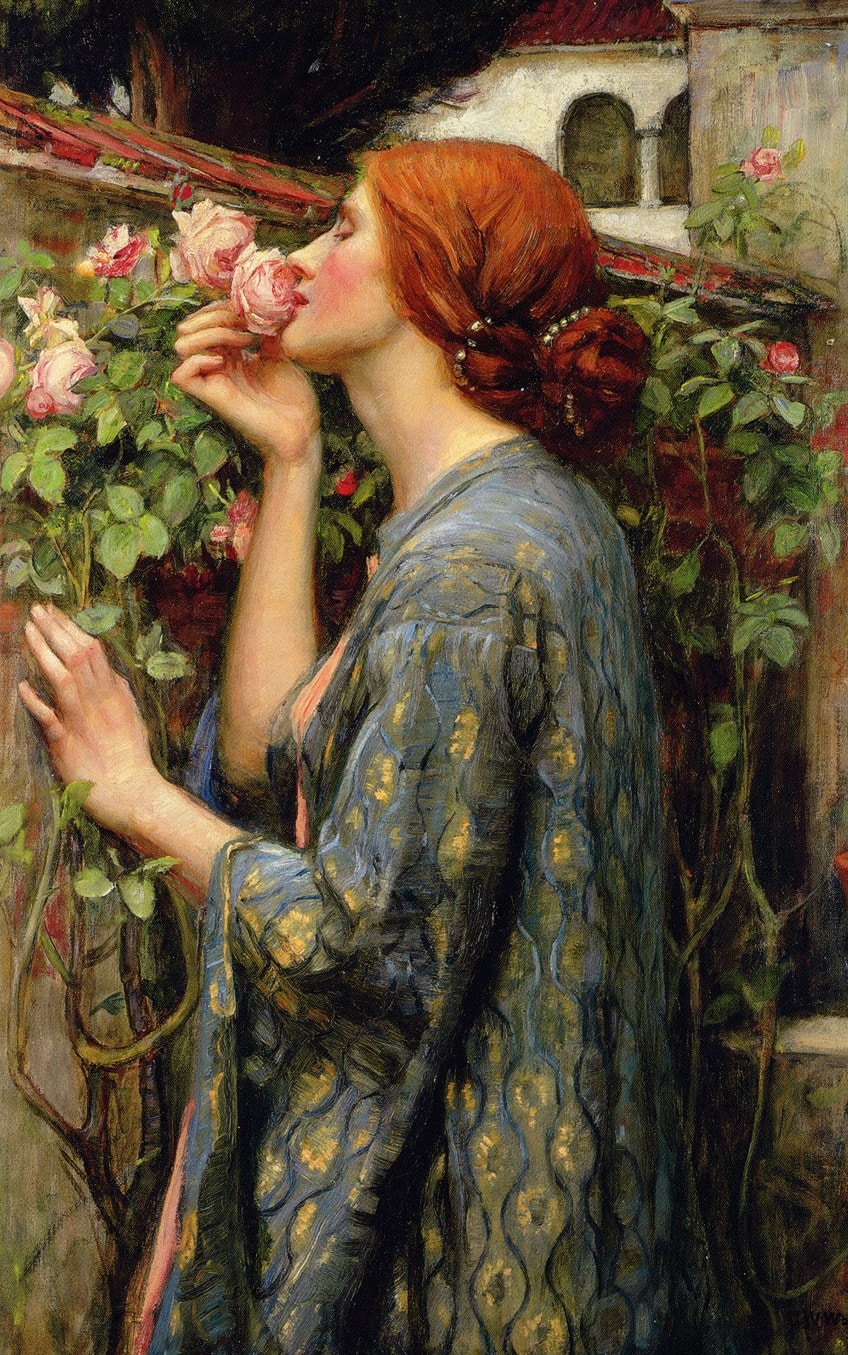
Taking Time to Smell the Roses
John William Waterhouse brought mythological scenes to visual life in his paintings, scenes of women in the forefront bedecked in beauty. The Soul of the Rose has been described as not based on a mythical tale or legend, but merely a study of a girl in a garden and possibly based on Alfred Tennyson’s poem about Maud.
Some art sources say that our female figure is lost in her own love and longing, experiencing the sensual richness of the rose and nature around her, but equally constrained by the walls keeping her in. Whether or not the woman is Maud, “The Soul of the Rose” is a poignant painting, delicately touching on numerous ideas about love, romance, loss, heartache, and longing. It is a visual portrayal of beautiful and tragic sentiments, and taking time to gaze at this composition is like taking time to smell a rose.
Take a look at our Soul of the Rose painting webstory here!
Frequently Asked Questions
Who Painted The Soul of the Rose?
The Soul of the Rose (1908) was painted by the English artist John William Waterhouse, who was born in 1849 and died in 1917. He became well-known for painting scenes about Medieval or Arthurian legends, as well as Greek mythology with women as the central figures.
What Is The Soul of the Rose by John William Waterhouse About?
The Soul of the Rose painting was inspired by Alfred, Lord Tennyson’s poem Maud and Other Poems (1855), specifically the poem called Maud (1854) or Come into the Garden, Maud. Other influences may have been from the Medieval poem by Guillaume de Lorris titled Le Roman de la Rose (c.1230).
What Was John William Waterhouse’s Art Style?
John William Waterhouse painted in the Academic Art and pre-Raphaelite Brotherhood art movements. Many of his paintings depict the themes explored by the pre-Raphaelite Brotherhood, but he reportedly also incorporated modern ideas in his compositions and not only themes based on mythology or legends.
Alicia du Plessis is a multidisciplinary writer. She completed her Bachelor of Arts degree, majoring in Art History and Classical Civilization, as well as two Honors, namely, in Art History and Education and Development, at the University of KwaZulu-Natal, South Africa. For her main Honors project in Art History, she explored perceptions of the San Bushmen’s identity and the concept of the “Other”. She has also looked at the use of photography in art and how it has been used to portray people’s lives.
Alicia’s other areas of interest in Art History include the process of writing about Art History and how to analyze paintings. Some of her favorite art movements include Impressionism and German Expressionism. She is yet to complete her Masters in Art History (she would like to do this abroad in Europe) having given it some time to first develop more professional experience with the interest to one day lecture it too.
Alicia has been working for artincontext.com since 2021 as an author and art history expert. She has specialized in painting analysis and is covering most of our painting analysis.
Learn more about Alicia du Plessis and the Art in Context Team.
Cite this Article
Alicia, du Plessis, ““The Soul of the Rose” by John William Waterhouse.” Art in Context. April 20, 2022. URL: https://artincontext.org/the-soul-of-the-rose-by-john-william-waterhouse/
du Plessis, A. (2022, 20 April). “The Soul of the Rose” by John William Waterhouse. Art in Context. https://artincontext.org/the-soul-of-the-rose-by-john-william-waterhouse/
du Plessis, Alicia. ““The Soul of the Rose” by John William Waterhouse.” Art in Context, April 20, 2022. https://artincontext.org/the-soul-of-the-rose-by-john-william-waterhouse/.


